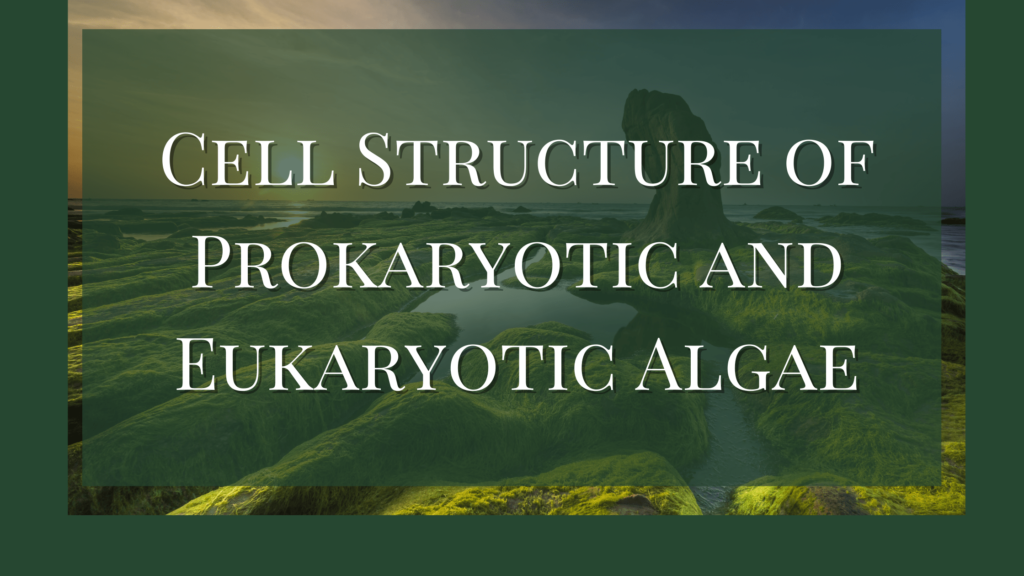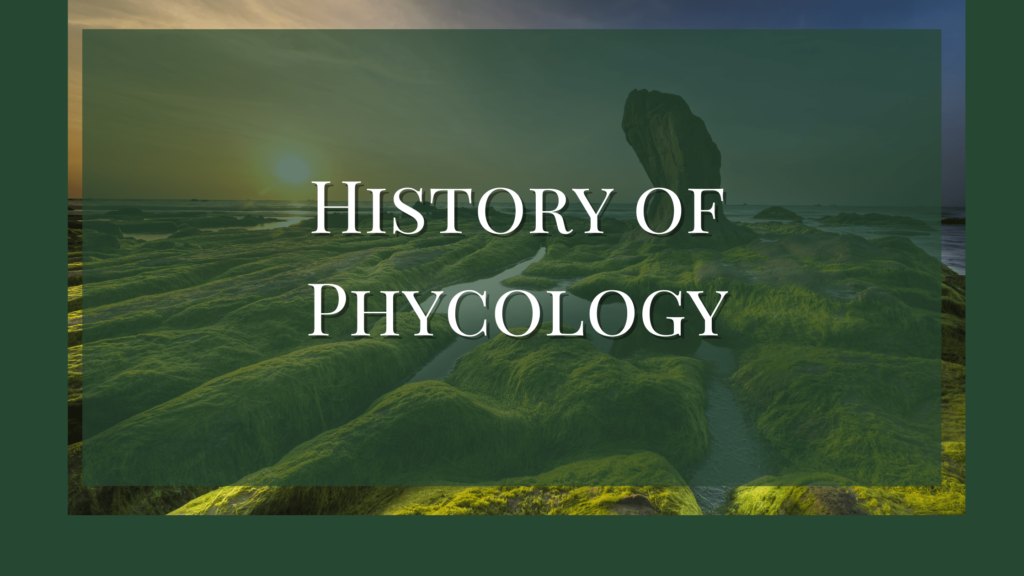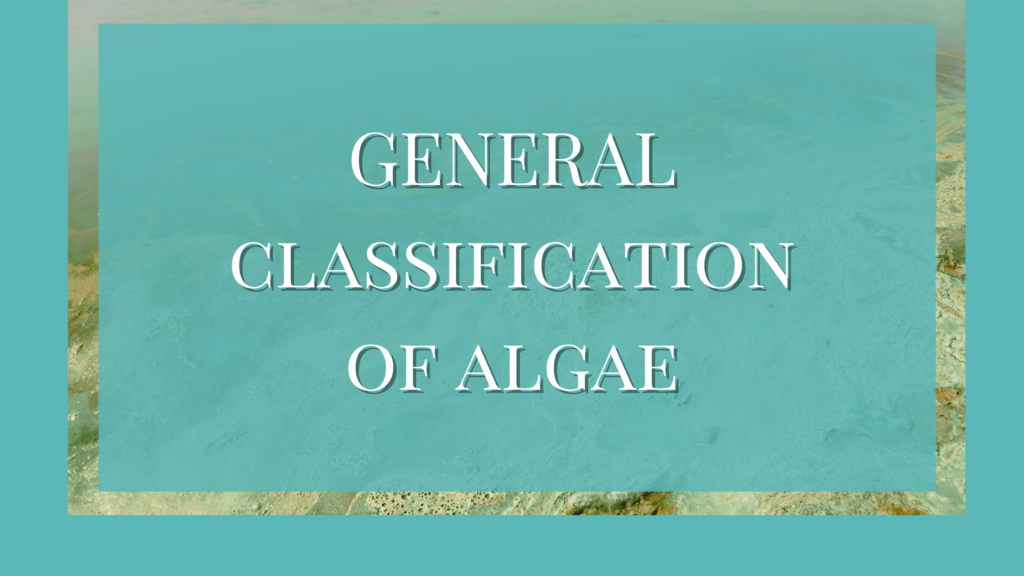Based on the cell structure of algae, it can be divided into prokaryotic and eukaryotic. The cell structure of algae is different in prokaryotic and eukaryotic algae.
The simple cells of blue-green algae as well as those of bacteria that lack a proper nucleus, nuclear membrane, or organelles such as mitochondria, and plastids, and that do not undergo mitosis are called prokaryotic cells. Here we will be discussing the ultrastructure of both these cell types.
Prokaryotic Cell Structure of Algae
The cell structure of algae in prokaryotes shows the presence of an incipient or primitive nucleus. The nucleus in such cells lacks a nuclear membrane and the DNA material is embedded in the nucleoplasm. This DNA does not have histone proteins either. The other features of such cells are,
- A mucilaginous sheath on the exterior.
- The cell wall is present but is made of mucopeptide. This mucopeptide is made of glucosamine and muramic acid, covalently bonded.
- It doesn’t have a strengthening component.
- Next to the cell wall is a plasma membrane.
- The DNA is made of fibrils and is located at the center or scattered throughout the cytoplasm.
- The mitotic figures are also absent in blue-green algae.
- The cytoplasm lacks major components such as mitochondria, endoplasmic reticulum, chloroplasts, etc.
- Instead of chloroplast, photosynthetic pigments are present in the lamellae or thylakoids. These structures are arranged in parallel rows and are seen in the periphery of the cytoplasm or throughout the cytoplasm in a network.
Eukaryotic Cell Structure of Algae
All types of algae except the blue-green algae exhibit eukaryotic cell structure. The cell structure of algae of eukaryotic type consists of a cell wall, cell organelles such as mitochondria, chloroplast, and plastids, and a developed nucleus with a nuclear membrane.
Cell Wall
- The cell wall of eukaryotic cells is made of cellulose, hemicellulose, mucilage, pectin, fucoidin, calcium carbonate, silica, alginic acid, fucin, etc.
- The cell wall material differs from one group to another.
- Diatoms have silica in their cell wall and have secondary structures as well.
- The cellulosic cell wall is made of cellulose microfibrils that are of different thicknesses. These microfibrils are oriented in a granular matrix.
Plasma membrane
- The cell membrane or plasma membrane protects the protoplast and its contents from the exterior.
- It is made of lipids and proteins in a fluid mosaic model structure.
- It is a thin membrane, has elasticity, and is selectively permeable.
- Its function is to control the movements of materials in and out of the cell.
Nucleus
A well-developed nucleus with a nuclear membrane helps distinguish the cell structure of algae- prokaryotic and eukaryotic. The presence of a chromatin thread embedded in the karyolymph is another characteristic feature of a eukaryotic cell. A eukaryotic algal cell is no different and has all these features.
- The nucleus is spherical or elliptical with a double-layered nuclear membrane.
- The outer layer is connected with the endoplasmic reticulum.
- Each nucleus has a single or more nucleolus which is also called endosomes. The number of nucleoli differs from one algal group to another.
- The chromosomes either appear in a diffused form of centromere or localized.
- The chromosome number is also different in each group. The number ranges from n=2 in Porphyra linearis to n=592 in Netrium digitali.
Mitochondria
The mitochondrion is the respiratory center of a eukaryotic cell. It is a double membrane structure with the inner matrix and other components.
- The outer layer of the membrane forms the envelope while the inner membrane invaginates to form sac-like cristae.
- The cristae help increase the surface area of the inner membrane.
- There is a gap between these two layers of the membrane and it is continuous with the inter-crisate space as well.
- The matrix of the mitochondrion is proteinaceous and has enzymes required for respiration and protein synthesis.
- Mitochondria has its DNA and ribosomes, making it semi-autonomous. They help with the synthesis of proteins.
- Algal cells usually have more than one mitochondrion except for Micromonas.
Endoplasmic Reticulum
- The endoplasmic reticulum (ER) is an extensive network of tubular membranes and cisternae. Cisternae are flattened disc-like structures.
- ER is seen throughout the cytoplasm and is connected to the nuclear membrane. The cisternae are parallel and interconnected.
- Ribosomes are often attached to the cisternae on the side which faces the cytoplasm. Not all cisternae have ribosomes on them.
- ER is differentiated into rough and smooth according to the presence or absence of ribosomes.
Chloroplast
The presence of chloroplast is another characteristic of the cell structure of algae in eukaryotic type. It is a double-membrane organelle that bears photosynthetic pigments. The basic structure of a chloroplast includes three main parts.
- A double-membraned envelope
- The stroma with embedded enzymes and other metabolites required for metabolic activities such as photosynthesis and stored starch.
- An organized lamellar membrane having chlorophyll pigments. Lamellae are also involved in the capture of energy and its transduction.
Lamellar System
The lamellar system consists of a stack of disc-like structures known as thylakoids. The thylakoid has internal space between them. The thylakoid membrane separates its cavity or inner space from the stroma. The membrane carries the photosynthetic pigments and electron carriers for the light reactions of photosynthesis.
The chloroplast is shaped differently in various types of algae. These shapes are
- C-shaped or Girdle-shaped in Ulothrix
- Cup-shaped in Chlamydomonas and Volvox
- Discoid in Chara, centric diatoms, and Vaucheria
- Parietal in pennate diatoms, members of Chaetophorales, Chrysophyceae, Phaeophyceae, and Rhodophyceae.
- Reticulate in algae such as Cladophora, Hydrodictyon, and Oedogonium.
- Ribbed in members of Volvocales
- Spiral as in Spirogyra
- Stellate in Zygnema
Golgi Apparatus
- Golgi Apparatus otherwise known as dictyosomes are seen as part of the cell structure of algae except blue-green algae.
- These are part of the endomembrane system often considered as an intermediary system between the ER and plasma membrane.
- The location of the Golgi apparatus may be anywhere in the cytoplasm.
- It is located near the nucleus in Chlamydomonas, next to plastids in Bulbochaete and diatoms.
- The structure of the Golgi apparatus reveals that they are flat vesicles stacked one over the other. The number of vesicles varies from 2 to 20. Each of such stacks is called a dictyosome. Several dictyosomes collectively form the Golgi apparatus.
- The functions of the Golgi apparatus include the formation of a plasma membrane, the strengthening of the cell wall, and to the packaging of materials to be transported out of the cell.
Vacuole
One of the common characteristics of algae is the presence of one or more vacuoles. Each vacuole has a membranous boundary called a tonoplast. There are three types of vacuoles.
- Simple vacuoles are small in size. They have regular contraction and expansion, so they are also called contractile vacuoles. Their function is to expel metabolic wastes and regulate water content. They regularly discharge excess water and function as a secretory agent of the cell.
- Complex vacuoles consist of a tube-like structure called cytopharynx, other vacuoles of varying sizes, and a large reservoir. These types of vacuoles are osmoregulatory in function and sometimes store reserve foods like chrysolaminarin and laminarin. Complex vacuoles are a characteristic feature of Dinophyceae and Euglenophyceae.
- Gas vacuoles are seen as stacks of transparent cylinder-like substances having uniform diameters and gas cavities. They function as a screen against bright light and provide buoyancy to the planktonic algae.
Pigments
Each alga has its characteristic color due to the presence of pigments. Each division of algae has its characteristic type of pigment that makes them a unique group. The pigments are seen in plastids and come in various shapes such as
- Cup-shaped
- Parietal plate
- Lens- shaped
- Disc
- Network like
- An axial band,
- Star-shaped or stellate
- Oval shaped
- Lobed disc
- Parietal ring
The four types of pigments present in algae are chlorophylls, carotenes, xanthophylls, and phycobilins.
Pyrenoid
Pyrenoids are proteinaceous bodies with densely packed proteinaceous fibrils. They are often seen with chloroplast or chromatophores. They can be present inside or on these organelles.
- They are the site of starch synthesis and accumulation.
- Pyrenoids are seen as transient structures in some algae.
- They can be seen as a single, more than one, or completely absent as in Cyanophyceae. Eg. Chlamydomonas, Oedogonium and Spirogyra.
Flagella
A flagellum is present in the vegetative cells of motile algae and reproductive cells of all algae. This feature is absent in members of Cyanophyceae and Rhodophyceae. Algae move with the help of the beating action of these thread-like structures.
Structure of Flagella
Flagella in algae is a protoplasmic appendage that can vary in number, size, and position. Each of them has two central fibrils and 9 peripheral fibrils in pairs.
They are extremely fine and emerged as an extension of cytoplasm. They have a basal body named blepharoplast or basal body, a central axial filament called an axoneme. Axoneme has a sheath of a cytoplasmic membrane that ends short of the apex. The naked or unprotected area of the apex of flagella is called the end-piece. When the algae has a cell wall, the flagellum extends through a pore.
Types of flagella
Some flagella have hair-like structures growing on them. Depending upon the type of algae the number of flagella can be one, two, four, or many. As per the presence or absence of hairs, flagella are classified into,
- Whiplash flagella is also called acronematic and has a smooth, hairless structure. These are otherwise known as acronematic.
- Tinsel flagella are also called pleuronemtaic and have lateral fine filamentous hairs present in one or several rows. These hair structures are called flimmers or mastigonemes. These are further divided into,
- Pantonematic– Mastigonemes in two opposite rows
- Pantoacronematic with a terminal fibril
- Stichonematic with one-sided mastigonemes
Algal cells with more than one identical flagella are called isokonts.
When algal cells have different types of flagella, it is called a heterokont.
Eye Spot or Stigma
Eye spots are the pigmented spots seen in motile reproductive and vegetative cells of algae. Eye Spots are seen in the anterior, posterior, or middle part of the cell body. This is a light-sensitive organelle that also takes part in the movement of the cell. While they are usually seen near the thylakoids, they can be present in other parts as well. Depending on where they are found, eye spots are of different types.
- Type A: Located in chloroplast and not associated with flagella
- Type B- located in chloroplast and associated with flagella.
- Type C- Located on the anterior side as independent clusters of osmiophilic granules.
- Type D- Located near the flagellar base and has an osmiophilic granular structure with a membranous lamella.
- Type E- Has a lens with the shape of a pigmented and retinoid cup.
Reserve food material
Autotrophic organisms such as algae produce their own food through photosynthesis. Depending upon the class of algae, this produced food is stored in different forms. This stored food is called reserve food. As far as the cell structure of algae is concerned, the type of reserve food is determined by the pigmentation of the algae.
- Green algae -starch
- Cyanophyceae- cyanophycean starch
- Rhodophyceae – floridean starch
- Phaeophyceae -mannitol and laminarin starch
References
M Sc I Semester- Algae and Bryophytes




